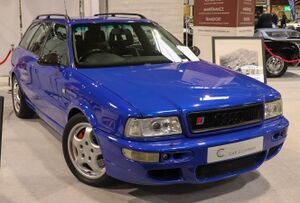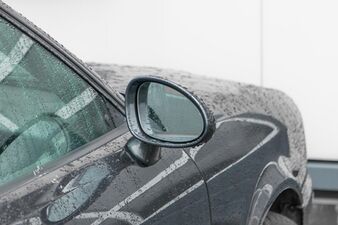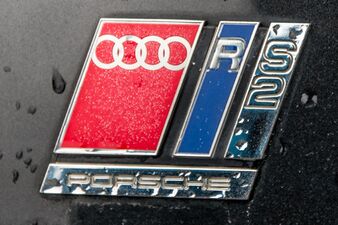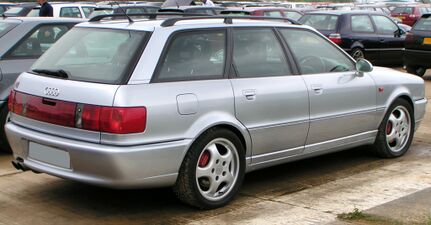Engineering:Audi RS 2 Avant
| Audi RS 2 Avant (8C) | |
|---|---|
 | |
| Overview | |
| Manufacturer | Audi AG and Porsche[1] |
| Production | March 1994 – July 1995[1] |
| Assembly | Germany: Zuffenhausen[1] (Porsche) |
| Body and chassis | |
| Class | Entry-level luxury car |
| Body style | 5-door estate car |
| Layout | longitudinal front engine, quattro permanent four-wheel drive[1] |
| Platform | Volkswagen Group B4 platform |
| Related | Audi 80 (B4) Avant[1] |
| Powertrain | |
| Engine | 2.2 I5 turbo limited to 7,500 rpm |
| Power output | 315 PS (311 bhp; 232 kW) |
| Transmission | 6-speed manual[1] |
| Dimensions | |
| Wheelbase | 2,611 mm (102.8 in) |
| Length | 4,580 mm (180.3 in) |
| Width | 1,694 mm (66.7 in) |
| Chronology | |
| Successor | Audi RS 4 |
The Audi RS 2 Avant is a high-performance version of the Audi 80 Avant estate car, manufactured from March 1994 to July 1995.[1] Collaboratively designed as a joint venture between Audi AG and Porsche and based on Audi's B4/8C platform, it received the internal designation of P1. It featured the most powerful version of Audi's inline-five cylinder turbocharged engine. It represents Audi's first "RS" model,[2] and the first of their high-performance Avants.
It is a limited-edition model that was not widely exported outside of Europe, except in limited quantity to Hong Kong, South Africa, Brazil, and New Zealand. However, the RS 2 has amassed a cult following worldwide including Canada and the United States where the RS 2 was not officially imported due to certification costs and weak brand performance in the early 1990s. RS 2s have now been imported to Canada and USA as both allow non-conforming vehicles to be imported once they reach the age of 15 and 25 years respectively.
Overview
The RS 2 was the product of a co-development project between Audi and Porsche, based on Audi's 80 Avant, and built on the Audi B4 platform. It was powered by a modified version of their 2,226 cc (2.2 L; 135.8 cu in) inline-five DOHC four valves per cylinder (20 valves total) turbocharged petrol engine (parts code prefix: 034, identification code: ADU).[1] This internal combustion engine produced a motive power output of 315 PS (311 bhp; 232 kW) at 6500 rpm and 410 N⋅m (302 lb⋅ft) at 3000 rpm of torque. Although much of the car's underpinnings were manufactured by Audi, assembly was handled by Porsche at their Rossle-Bau plant in Zuffenhausen, Germany , which had become available after discontinuation of the Mercedes-Benz 500E, which Porsche had manufactured there under contract. The Rossle-Bau plant also produced the famous Porsche 959.
Like the rest of the vehicle, the RS 2's five-cylinder engine was based on a unit that Audi already produced, although Porsche considerably modified the engine; the standard KK&K turbocharger was switched for a larger unit, along with a heavy-duty intercooler and higher flow fuel injectors, a newly designed camshaft, a more efficient induction system, and a low-pressure exhaust system replaced the standard fare; a specially modified URS4/URS6 Bosch-supplied engine control unit (ECU) controlled the engine.
With so much power available, the RS 2 could accelerate from 0 to 100 km/h (62 mph) in 4.8 seconds, and achieve a maximum speed of 262 km/h (163 mph) (electronically restricted), despite weighing over 1,600 kg (3,500 lb). In a road test conducted in 1995, British car magazine Autocar timed the RS 2 from 0 to 30 mph (48 km/h) at just 1.5 seconds, which they confirmed was faster than the McLaren F1 road car. Even by more modern standards, its performance is exceptional; it could accelerate on-par with the 5th generation Chevrolet Corvette (C5) and a 996 generation Porsche 911.
A six-speed manual gearbox (parts code prefix: 01E, identification code: CRB) (gear ratios - 1st: 3.500, 2nd: 1.889, 3rd: 1.320, 4th: 1.034, 5th: 0.857, 6th: 0.711)[1] was the only transmission choice. Audi's Torsen-based[1] 'trademark' quattro permanent four-wheel drive system was standard. Front and rear final drive units contained a conventional 'open' differential, and have a ratio of 4.111, although the rear (parts code prefix: 01H, identification code: AZE) also has an electro-mechanical diff lock.[1]
Porsche-designed braking and suspension systems replaced the standard Audi 80 equipment, however, the Bosch Anti-lock braking system (ABS) was retained. The front brakes[1] feature either 304 millimetres (11.97 in) in diameter by 32 mm (1.260 in) thick radially ventilated disc brakes, and use Brembo four-opposed piston fixed calipers, or a 'modified' option of larger discs (which will only fit under a 17" wheel) of 322 mm (12.68 in) by 32 mm (1.260 in), with uprated brake pads. The rears[1] featured 299 mm (11.77 in) by 24 mm (0.945 in) radially vented discs, again with Brembo four-piston calipers, and the 'modified' option included identical sized discs, but merely included cross-drilling, along with uprated pads. The hand brake[1] worked on the rears, and consisted of a cable operated 'drum in disc' system.
40 millimetres (1.6 in) lower than a standard 80 Avant, the suspension and braking upgrades combined to give the RS 2 the handling and braking capabilities of a high-end sports car; 7.0Jx17 inch Porsche 'Cup' wheels,[1] and high-performance 245/40 ZR17 Dunlop tyres were standard as well. In fact, the braking system wore Porsche-badged Brembo calipers, and both the wheels and side mirrors were identical in design to those of the 964 Turbo. Additionally, the word "PORSCHE" is inscribed in the RS 2 emblem affixed to the rear tailgate and front grille.
A three-spoke leather steering wheel, Recaro sports-bucket seats (available in full leather or a leather/suede combination), and console materials in either wood or carbon fiber trim rounded out the vehicle's interior changes. Audi's proprietary Safety Restraint System, procon-ten remained from its donor vehicle.[1]
Audi also produced an S2, which was available both as an Avant (estate) and a Coupé, as well as saloon model with only 306 examples built. It featured a similar turbocharged 2,226 cm3 (135.8 cu in) five-cylinder engine which delivered 162 kW (220 PS; 217 bhp) (3B engine), or 169 kW (230 PS; 227 bhp) (ABY engine).
See also
References
External links
- Audi.com Audi corporate website
 |







